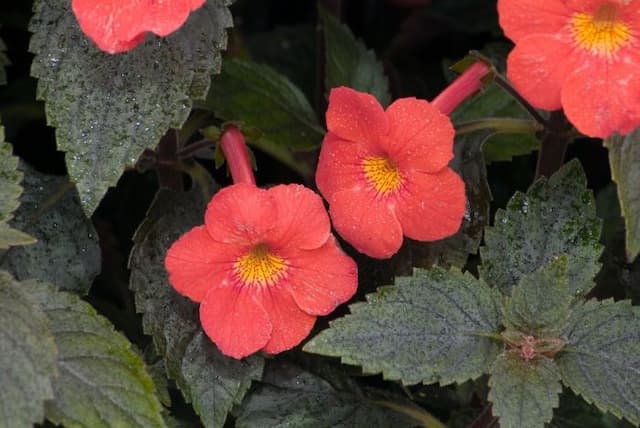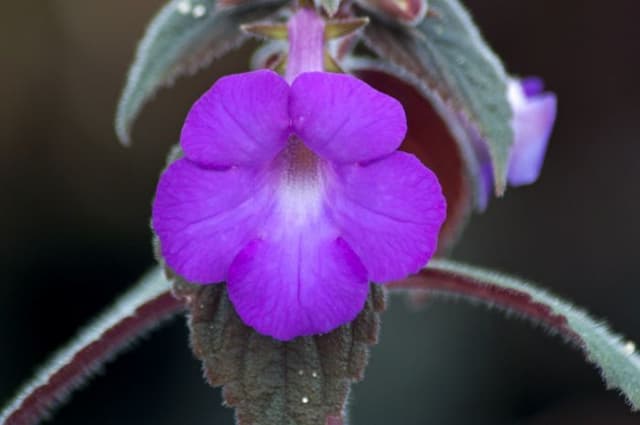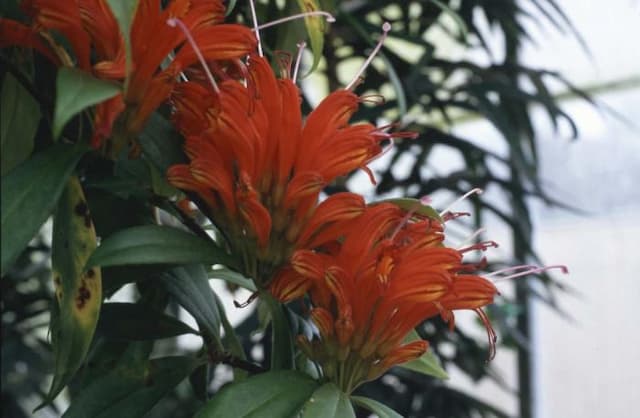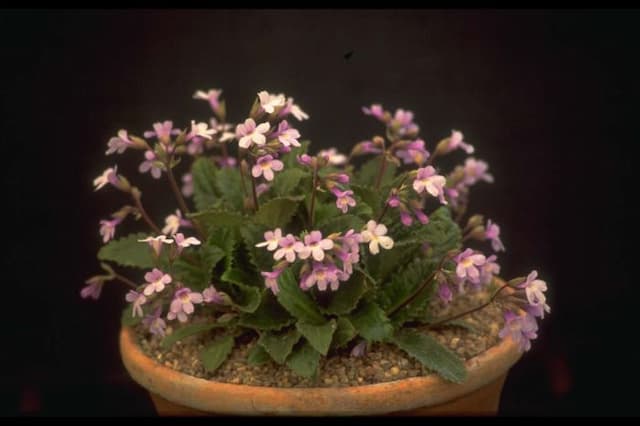Cape Primrose Streptocarpus 'Texas Hot Chili'

ABOUT
Streptocarpus 'Texas Hot Chili', commonly known as Cape Primrose, presents a vibrant display of blossoms and foliage. The flowers are particularly eye-catching, with fiery red hues accentuated by a smoldering blend of warm colors that may include orange and yellow tones, emulating the spicy vigor of a hot chili pepper. These vivid flowers tend to have a trumpet-like formation, characterized by a flared and open mouth. This variety of Cape Primrose typically bears blooms that are prolific and can create a stunning display of color for extended periods. Each individual flower emerges on slender stems that rise from the plant's base. The plant itself has a rosette-like structure made up of elongated, soft leaves that often showcase a lush, deep green color. The foliage can have a velvety texture, adding a tactile dimension to its already charming appearance. The entire presentation of Streptocarpus 'Texas Hot Chili' is that of an attractive and compact plant, with its brilliant blooms often overshadowing the leaves, making it a popular choice for those seeking to add a pop of color to their indoor plant collection.
About this plant
 Names
NamesFamily
Gesneriaceae
Synonyms
Cape Primrose, African Violet
Common names
Streptocarpus 'Texas Hot Chili'
 Toxicity
ToxicityTo humans
Generally, the cape primrose is not toxic to humans. There is no concrete evidence to suggest that Streptocarpus 'Texas Hot Chili', which is a variety of cape primrose, is poisonous if ingested. However, it is always wise to exercise caution and avoid eating ornamental plants, as they are not intended for human consumption.
To pets
The cape primrose is also considered non-toxic to pets. This means that Streptocarpus 'Texas Hot Chili' is unlikely to cause harm if a pet, like a cat or dog, ingests parts of the plant. Nonetheless, ingestion of non-food items can sometimes lead to gastrointestinal upset or other non-toxic related issues in pets, so it is generally best to keep ornamental plants out of their reach.
 Characteristics
CharacteristicsLife cycle
Perennials
Foliage type
Evergreen
Color of leaves
Green
Flower color
Red
Height
1 foot (30 cm)
Spread
1 foot (30 cm)
Plant type
Herb
Hardiness zones
10
Native area
Africa
Benefits
 General Benefits
General Benefits- Easy Care: Streptocarpus Texas Hot Chili is known for being low-maintenance, requiring minimal care once established.
- Ornamental: It has attractive foliage and vibrant flowers, enhancing the aesthetic value of indoor spaces.
- Long Blooming: This plant has a long blooming period, providing a consistent display of color in your home or garden.
- Compact Size: Its small stature makes it ideal for windowsills, desktops, and small spaces.
- Shade Tolerance: It can thrive in low-light conditions where other flowering plants might struggle.
- Humidity Resistance: It is well-suited to humid environments, which makes it a good choice for bathrooms and kitchens.
 Medical Properties
Medical PropertiesThis plant is not used for medical purposes.
 Air-purifying Qualities
Air-purifying QualitiesThis plant is not specifically known for air purifying qualities.
 Other Uses
Other Uses- Photography Subject: The vibrant colors and unique patterns of the Streptocarpus make it a popular subject for macro and botanical photographers.
- Educational Tool: Horticulture teachers sometimes use Streptocarpus plants to demonstrate plant care, propagation, and floral structure to students.
- Art Inspiration: The intricate details and striking colors of the blooms can serve as inspiration for artists, especially for botanical illustration.
- Gift Plant: Its attractive appearance and relatively easy care make the Streptocarpus a favored choice for gifting on special occasions like Mother's Day.
- Craft Projects: Dried Streptocarpus flowers can be used in craft projects, such as in flower pressing or making greeting cards.
- Table Decor: Live Streptocarpus plants or cut flowers can be used as centerpieces or table decor in homes and at events.
- Plant Competitions: Enthusiasts may grow Streptocarpus for entering horticultural contests or shows, where the most beautiful or unusual specimens are awarded.
- Collector’s Item: Some plant collectors treasure Streptocarpus for their variety and seek rare or unusual cultivars to add to their indoor gardens.
- Color Therapy: The vivid colors of the Streptocarpus flowers may be used in color therapy practices to inspire energy and creativity.
- Yoga and Meditation Enhancer: The calming presence of flowering Streptocarpus plants can complement the tranquil environment of spaces dedicated to yoga and meditation.
Interesting Facts
 Feng Shui
Feng ShuiThe Cape Primrose is not used in Feng Shui practice.
 Zodiac Sign Compitability
Zodiac Sign CompitabilityThe Cape Primrose is not used in astrology practice.
 Plant Symbolism
Plant Symbolism- Resilience: The Cape Primrose (most common name of Streptocarpus 'Texas Hot Chili') survives in shaded environments, symbolizing the ability to thrive under challenging conditions.
- Vibrancy: With its vivid red blooms, this plant represents a vibrant spirit and enthusiastic energy, often associated with excitement and passion.
- Adaptability: The Cape Primrose is known for its adaptable nature in various indoor conditions, signifying flexibility and the capacity to adjust to different situations in life.
 Water
WaterCape Primroses, including the 'Texas Hot Chili' variety, prefer consistent moisture, but it's crucial not to let their roots sit in water. Water them when the top inch of soil feels dry to the touch, which is typically once a week, but this can vary depending on environmental conditions. Use room temperature water and add it slowly to the pot until water runs through the drainage holes, which might mean using about 8-16 onzes for a standard pot. Adjust the amount of water seasonally, reducing it in winter when plant growth slows down. Always check the soil moisture level before each watering to avoid overwatering.
 Light
LightCape Primroses like 'Texas Hot Chili' thrive in bright, indirect light. They should be placed in a spot that gets plenty of ambient light without direct sun exposure, as intense direct sunlight can burn the leaves. An east or north-facing window is often ideal for providing the right light conditions without the harsh direct sun of south or west-facing windows.
 Temperature
TemperatureCape Primroses, including the 'Texas Hot Chili' variety, do best in temperatures ranging from 60 to 75°F. They can survive minimum temperatures of 50°F but do not tolerate cold drafts or temperatures below this. The ideal temperature range promotes healthy growth and flowering, so try to maintain a stable environment within these temperatures.
 Pruning
PruningPrune Cape Primroses 'Texas Hot Chili' to remove any yellowed or dead leaves and spent flowers to maintain the plant's appearance and encourage new growth. This can be done as needed throughout the year, but is especially important after a bloom cycle. Pruning also helps in preventing diseases by promoting good air circulation around the plant. The best time for major pruning is early spring, just before the onset of the vigorous growing season.
 Cleaning
CleaningAs needed
 Soil
SoilCape Primrose prefers well-draining potting mix with added perlite or vermiculite. The ideal pH range is slightly acidic to neutral, around 6.0 to 7.0. An orchid mix or African violet mix is also suitable for this plant.
 Repotting
RepottingCape Primrose should be repotted every 12-18 months or when it becomes root-bound. Spring is the best time to repot this plant to minimize stress and promote healthy growth.
 Humidity & Misting
Humidity & MistingCape Primrose thrives in moderate to high humidity levels around 50-60%. If the air is too dry, the leaves can start to brown at the edges.
 Suitable locations
Suitable locationsIndoor
Keep in bright, indirect light, and avoid cold drafts.
Outdoor
Place in dappled shade, protect from harsh sun and frost.
Hardiness zone
10-11 USDA
 Life cycle
Life cycleThe life of a Texas Hot Chili Streptocarpus begins with germination, where the seed absorbs water and starts to sprout, typically preferring warm conditions for optimal growth. The seedling stage follows, characterized by the emergence of the first set of true leaves. As the plant enters the vegetative stage, it develops a rosette of lush foliage, which is a hallmark of Streptocarpus plants. This stage is crucial for photosynthesis and energy accumulation. During the flowering stage, Texas Hot Chili produces vibrant, chili-colored blooms that can last for several months, given the right conditions. After pollination, the plant may produce seeds, completing the life cycle, or it may continue to grow vegetatively and bloom periodically if conditions remain favorable.
 Propogation
PropogationPropogation time
Spring-Early Summer
Streptocarpus 'Texas Hot Chili', more commonly known as Cape Primrose, can typically be propagated through leaf cuttings, a popular and straightforward method. The best time for propagation is during spring or early summer when the plant is actively growing. To propagate, select a healthy, mature leaf and cut it across width-wise into sections, each about 1.5 to 2 inches (approximately 4 to 5 centimeters) long, ensuring each piece has a vein. These sections are then placed into a moist potting mix, ideally with the cut edge slightly buried. It's important to maintain high humidity and warmth, around 70°F (approximately 21°C), to encourage rooting. Roots and new growth usually appear in a few weeks, after which the new plants can be potted individually.









